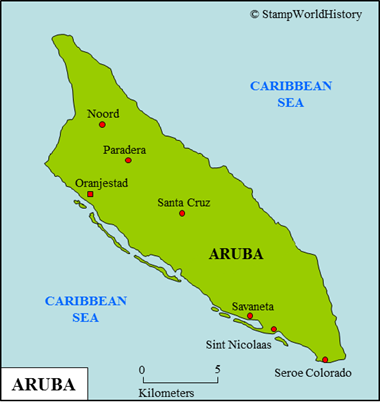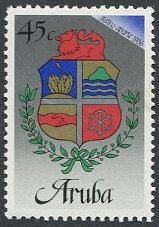
Aruba
Quick reference
General issues: Self governing country within the Kingdom of the Netherlands 1986-Present
Country name on general issues: Aruba
Currency: 1 Gulden = 100 Cents 1986-Present
Population: 112 000 in 2015
Political history Aruba
Aruba is located in the Caribbean as one of the Leeward Antilles off the coast of Venezuela – for the exact location, please refer to the map of the Caribbean. Aruba was, prior to colonization, inhabited by the Amerindian Caquetio people originating from Venezuela. The first Europeans to explore the islands were the Spanish in 1499. The Spanish claimed and settled the island. The Dutch established their first permanent settlement in 1636 and Spain acknowledged Dutch sovereignty in 1648. Initially, Aruba was administered by the Dutch West India Company, a chartered company, but the island was transferred to the Dutch Crown in 1791. The British took control of Aruba during the French Revolutionary and Napoleonic Wars. Dutch sovereignty was restored in 1815. From 1848, Aruba was administered as part of the colony of Curacao & Dependencies, together with the other Dutch possessions in the Caribbean. Curacao & Dependencies was renamed the Netherlands Antilles in 1948. The Netherlands Antilles became a constituent country in the Kingdom of the Netherlands in 1954 and, as such, self governing. Aruba broke away from the Netherlands Antilles, in 1986, to become a self governing country within the Kingdom of the Netherlands itself – which it is until today.
During most of the colonial period, Aruba was little developed economically – the climate was not suitable for the development of plantations and trade was concentrated in neighboring Curacao. Things changed as, in the 20th century, oil refineries were set up as a spin off of the discovery of large oil deposits in Venezuela. Furthermore, tourism rapidly developed to become the mainstay of the economy of the island. Currently, in terms of per capita GDP, Aruba ranks high among the Caribbean islands. The majority of the population – 80% – are of mixed Amerindian and European descent, which reflects the fact that the island was never developed as a plantations economy and, thus, slaves were brought to the island only in small numbers.
Postal history Aruba
The first post office was set up on Aruba in the 1880’s. The stamps of Curacao & Dependencies were used until 1948, when these were superseded by the stamps of the Netherlands Antilles. Aruba issued its first stamps in 1986 – a set commemorating the newly acquired status of a self governing country. While Aruba initially issued stamps, mainly with themes of national interest, in recent years the focus has shifted to designs aimed at the thematic collectors market.
Album pages
← Previous page: ArgentinaNext page: Bahamas →



